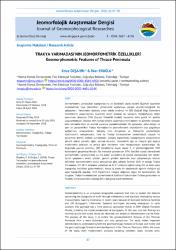| dc.contributor.author | Özşahin, Emre | |
| dc.contributor.author | Eroğlu, İlker | |
| dc.date.accessioned | 2022-05-11T14:28:45Z | |
| dc.date.available | 2022-05-11T14:28:45Z | |
| dc.date.issued | 2018 | |
| dc.identifier.issn | 2667-4238 | |
| dc.identifier.uri | https://app.trdizin.gov.tr/makale/TXpVMU56UTJOZz09 | |
| dc.identifier.uri | https://hdl.handle.net/20.500.11776/6931 | |
| dc.description.abstract | Jeomorfometri, yeryüzünün topoğrafyasına ait özellikleri çeşitli türden ölçümler sayesindematematiksel veya istatistiksel yöntemlerle açıklamaya çalışan analitik-kartoğrafik biryaklaşımdır. Yerbilimleri alanında artan teknik imkânlar ve CBS (Coğrafi Bilgi Sistemleri)tekniklerinin yaygınlaşması sayesinde önem kazanan bu yaklaşım, topoğrafyanın dijitalsunumunu oluşturan SYM (Sayısal Yükseklik Modeli) sayesinde daha pratik bir şekildeuygulanmaktadır. Böylece hem somut verilere ulaşılmakta hem kaliteli ve güvenilir sonuçlarelde edilmekte hem de analitik yorumlar yapılabilmektedir. Bu çalışmada, daha detaylı veyeni bir perspektiften Trakya Yarımadası’nın jeomorfometrik özelliklerinin ana çizgileriyleaçıklanması amaçlanmıştır. Çalışma, hem Avrupa’nın ve Türkiye’nin jeomorfolojiközelliklerinin anlaşılmasına, hem de Trakya Yarımadası’nın jeomorfolojik oluşum vegelişimine önemli katkılar sunmaktadır. Çalışma kapsamında, topoğrafyanın anlaşılmasınayönelik olarak yükselti, eğim, yarılma derecesi, hipsometrik eğri ve integral gibi başlıcamorfometrik analizler ve amaca göre belirlenen indis hesaplamaları kullanılmıştır. Bubağlamda yapılan analizler, CBS tekniklerine dayalı olarak 5 m çözünürlüğündeki SYMkullanılarak gerçekleştirilmiştir. Bu maksatla yararlanılan SYM, özellikle ulusal literatürdekijeomorfometri çalışmalarında şu ana kadar kullanılmış en yüksek çözünürlüklü veri setidir.Ayrıca çalışmanın analiz çıktıları, gerekli görülen alanlarda arazi çalışmalarıyla kontroledilmiştir. Jeomorfometrik analiz sonuçlarına göre yükselti farkının 1031 m olduğu TrakyaYarımadası, 155.68 m ortalama yükseltiye ve % 3.7 ortalama eğime sahip düz ve düze yakıntopoğrafya özellikleri göstermektedir. Ayrıca iç bükey bir hipsometrik eğrinin varlığına yolaçan topoğrafik koşullar, 0.15 hipsometrik integral değeriyle olgun bir karakterdedir. Bubulgular, Trakya Yarımadası’nın jeomorfometrik özellikleri bakımından Türkiye genelinden veAnadolu Yarımadası’ndan oldukça farklı olduğuna işaret etmektedir. | en_US |
| dc.description.abstract | Geomorphometry is an analytical-cartographic approach that tries to explain the features concerning the topography of earth through mathematical and statistical methods by various measurements. Gaining importance in recent years because of increased technical facilities and GIS (Geographic Information Systems) techniques becoming widespread in earth sciences, this approach has a more practical application thanks to DEM (Digital Elevation Model), providing the digital presentation of topography. In this way, concrete findings are reached; quality and sound results are obtained; and analytical interpretations can be made. The purpose of this study is to outline the geomorphometric features of the Thracian Peninsula from a more elaborated and new perspective. The study makes important contributions to understanding both the geomorphologic features of Europe and Turkey and the geomorphologic formation and development of the Thracian Peninsula. Within the scope of the study, main morphometric analyses including elevation, slope, incision level, hypsometric curve, and integral were made, and index calculations fit for the purpose were carried out to understand the topography of the area. Such analyses were conducted by use of 5 m resolution DEM based on GIS techniques. DEM, used for the said purpose, is the highest resolution dataset used so far in geomorphometric studies, especially in those conducted in Turkey. The analysis results obtained in the study were checked with field surveys conducted in the areas where they were considered necessary. According to the geomorphometric analysis results, the Thracian Peninsula, where rise is 1031 m, has smooth and close to smooth topographic features with an average elevation of 155.68 m and an average slope of 3.7%. In addition, topographic conditions, leading to the existence of a concave hypsometric curve, have a mature character with a hypsometric integral value of 0.15. These findings show that the Thracian Peninsula is quite different from Turkey as a whole and the Anatolian Peninsula in terms of geomorphometric features. | en_US |
| dc.language.iso | tur | en_US |
| dc.rights | info:eu-repo/semantics/openAccess | en_US |
| dc.title | Trakya Yarımadası'nın Jeomorfometrik Özellikleri | en_US |
| dc.title.alternative | Geomorphometric Features of Thrace Peninsula | en_US |
| dc.type | article | en_US |
| dc.relation.ispartof | Jeomorfolojik Araştırmalar Dergisi (Online) | en_US |
| dc.department | Fakülteler, Fen Edebiyat Fakültesi, Coğrafya Bölümü | en_US |
| dc.identifier.volume | 0 | en_US |
| dc.identifier.issue | 1 | en_US |
| dc.identifier.startpage | 87 | en_US |
| dc.identifier.endpage | 98 | en_US |
| dc.institutionauthor | Özşahin, Emre | |
| dc.institutionauthor | Eroğlu, İlker | |
| dc.identifier.trdizinid | TXpVMU56UTJOZz09 | en_US |



















